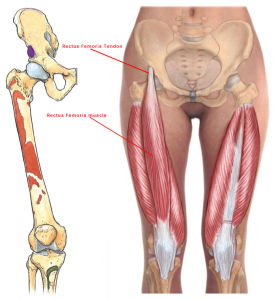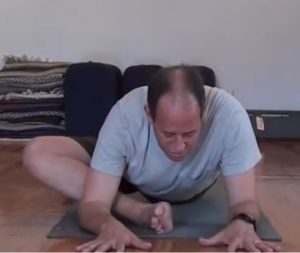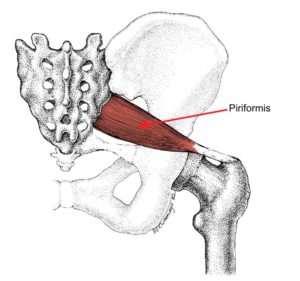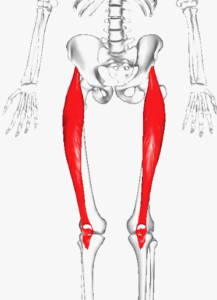 Stress in the rectus femoris tendon creates an environment that increases the likelihood of getting piriformis syndrome. And it tends to be one stressed out tendon.
Stress in the rectus femoris tendon creates an environment that increases the likelihood of getting piriformis syndrome. And it tends to be one stressed out tendon.
The rectus femoris tendon attaches in two places on the pelvis— the acetabulum, the cup that the femur (thigh) bone sits into, and the front border of the hip bone.
Of the four quadriceps muscles, it is the only one to attach to the pelvis which is what makes it a flexor of the hip as well as an extensor of the knee.
The rectus femoris tendon and muscle suffer terribly when it comes to poor posture.
I wrote earlier in the week about ligaments that hold us up when we don’t stand well and from a muscular point of view the rectus femoris tendon bears the full brunt of poor alignment in the legs and pelvis.
The video above is an exercise that I learned from one of my all-time favorite teachers Jim Bernaert.

We used to do this are his classes at Yoga Mandali in NYC, and I would look around in wonder at the moans and groans emanating from the students.
My open hips could care less and I would lay flat on my back whistling Dixie.
Over the years I came to see this pose as a piriformis muscle release that can provide great relief for piriformis syndrome and related issues.
To say that something is a piriformis release is simply to put the piriformis in a position to shut off and relax for a little while.

As I wrote yesterday, with poor posture and a tucked pelvis the piriformis lives in a state of constant contraction.
What is really happening here is that the rectus femoris tendon is getting worked in a way that it rarely does.
Standing with a misaligned pelvis forces the thigh forward which put stress on the iliofemoral ligament, but it also loads a ton of tension into the rectus femoris tendon essentially pushing it forward out of its natural alignment any time you are standing up.
In a way this tendon, which isn’t meant to stretch, is holding us up in the same way as the iliofemoral ligament. As a result, the poorly aligned and extremely tight rectus femoris tendon and muscle keep the piriformis muscle in its constantly contracted state.

If you are someone who feels like a steel cable becomes taught in the upper thigh when you do core work, you are feeling the rectus femoris tendon firing due to confusion and dysfunction. This type of action must be avoided and can be very difficult to change.
Trying the exercise in the video and then doing poses that usually make the rectus femoris tendon pop is a great way to explore the effectiveness of the exercise.
Another neat benefit of this shape, and the way I use it in yoga classes, is using it to go deeper into ankle-to-knee pose, an absolutely bedeviling shape that deserves a post of its own.
Align the pelvis and legs correctly and you will take a lot of strain off of the rectus femoris tendon which is a key muscle when it comes to walking, standing, and doing anything that involves flexing the hip.
Relieving this strain will have a secondary effect allowing the piriformis more space to live in its natural habitat.
Having taught this pose in so many yoga classes and to so many clients over the years, I have seen its effects on the rectus femoris tendon and they are nothing short of amazing.
